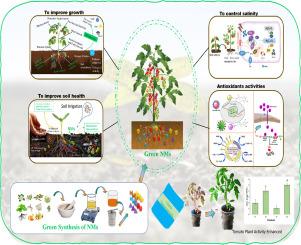用于番茄植物栽培的生物启发绿色纳米材料:绿色纳米技术在农业中的创新应用
IF 5.5
Q1 ENGINEERING, CHEMICAL
引用次数: 0
摘要
近年来,由于绿色纳米材料在改变植物发育、提高作物产量、防治疾病和病虫害管理等方面具有潜力,因此越来越多地应用于园艺和农业领域。值得注意的是,绿色纳米材料可通过提高稳定性、吸收和溶解效率来增强营养输送。绿色纳米材料利用无毒前体、减少废物策略、可再生资源和节能工艺,实现了可持续的技术进步。此外,西红柿作为最大的家庭和工业作物,全球产量约为 2 亿吨。番茄具有净化血液、促进肠胃分泌和减少营养成分的功效。然而,西红柿易受早疫病、败酱病叶斑病、晚疫病和褐斑病等病害的侵袭。因此,绿色纳米材料有可能通过改善病害管理、快速检测病害、提高养分吸收率、安全输送农用化学品和减少农药用量等方式为农业带来革命性的变化。有鉴于此,在本综述论文中,我们探讨了绿色纳米材料在番茄生长和发育中的应用,并研究了其独特性、利用、挑战和未来前景。最终,这篇综述将为植物基纳米材料及其在各学科中的应用,尤其是在作物保护、生长和土壤健康方面的应用,开辟一条新的研究道路。本文章由计算机程序翻译,如有差异,请以英文原文为准。

Bio-inspired green nanomaterials for tomato plant cultivation: An innovative approach of green nanotechnology in agriculture
In recent years, green nanomaterials are increasingly being utilized in horticulture and agriculture due to their potential to transform plant development, improve crop yield, combat diseases, and pest management, among other applications. Significantly, green nanomaterials enhance nutrient delivery by improving stability, uptake, and solubility efficiency. Utilizing non-toxic precursors, waste reduction strategies, renewable resources, and energy-efficient processes, they offer sustainable technology advancement. Moreover, tomatoes, the largest domestic and industrial crop, yield around 200 million tons globally. They are beneficial for blood cleansing, gastrointestinal secretion, and nutrient reduction. However, they are susceptible to diseases like early blight, septoria leaf spot, late blight, and buckeye rot. In this regard, green nanomaterials have the potential to revolutionize agriculture by improving disease management, detecting diseases quickly, enhancing nutrient uptake, safely delivering agrochemicals, and reducing pesticide dosage. So, impressed by this, in this current review paper, we explored the use of green nanomaterials for tomato growth, and development and investigated their unique features, utilization, challenges, and future prospects. Ultimately, this review will open a new research gateway for plant-based nanomaterial and their utilization in various disciplines particularly for crop protection, growth, and soil health.
求助全文
通过发布文献求助,成功后即可免费获取论文全文。
去求助
来源期刊

Chemical Engineering Journal Advances
Engineering-Industrial and Manufacturing Engineering
CiteScore
8.30
自引率
0.00%
发文量
213
审稿时长
26 days
 求助内容:
求助内容: 应助结果提醒方式:
应助结果提醒方式:


